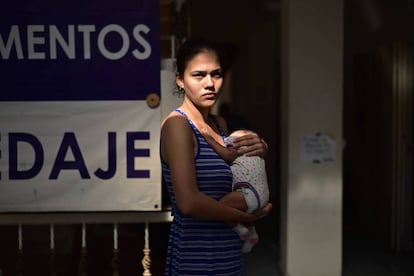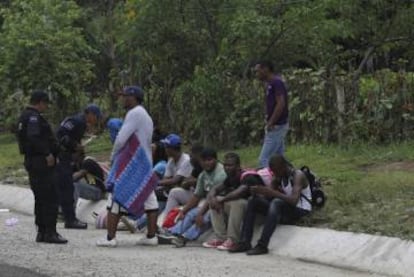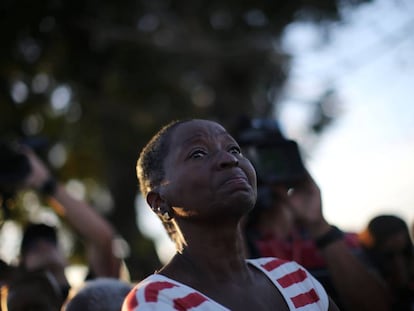Cuban migrants: “What Mexico is doing to us is inhuman”
When US ended ‘wet foot, dry foot’ policy, hundreds of islanders got trapped near end of their journey

Elaine Miranda, 25, could no longer go on. Her journey to the United States had begun in Trinidad and Tobago when she was eight weeks pregnant. She and her husband Marcos Delgado, 25, slowly advanced north through the Amazon region and Guyana. The most complicated part of the trip, through the jungle of Darién in Panama, came when she was about to give birth.

“I somehow found the strength to go on, in the hopes of reaching the United States,” she recalls proudly.
Eight men carried her in their arms for two days, when the contractions became too much to bear. Some time later, a helicopter took her to a hospital in the capital.
Liz María was born on December 12 and registered as a Panamanian citizen. After a 20-day rest, the family took up their journey once again.
They and around 50 other Cubans are staying at the Plaza Emanuel hotel in downtown Tapachula, a southern Mexican town located just a few kilometers from the border with Guatemala.
The only thing I am asking Mexico is to get them out of here; after that, we’ll see what happens with Donald Trump
Alexander Pereira, migrant
They are there as a result of the United States’ decision to end its “wet foot, dry foot” policy allowing Cubans who made it into US soil to stay and apply for residency. The decades-long approach was nixed on January 12.
Downtown Tapachula feels like a miniature Havana. It is a small parallel world filled with precarious accommodation going for one dollar a night, mafias keen to fleece the desperate migrants, and telephones that keep ringing in the hopes that Washington will repeal its decision and allow them to pursue their American dream.
“They started coming a year ago. Before that, it was unusual for them to come this way. I’d never seen as many Cubans as I see now,” says María Teresa Barrios, 52, who runs a beauty parlor near the hotel. “Unfortunately, they are being taken advantage of; a lot of people are benefiting from their despair and fear.”

Inside the hotel, there is an old Sony TV set that is always on, while people talk on their cellphones, wash their clothes and try to while away the time as they lie on old mattresses. Lester Ávila turns up the volume on the TV.
“Look, it’s the people we were with!” exclaims his cousin Yudalmi Quezada. The images are showing migrants trapped in Costa Rica who were held back by strict border controls in Nicaragua.
“This is the same news as four days ago. When are they going to say something new and give us a way out?” says one of the viewers. The others keep silent, looking depressed and strained.
“Barack Obama has created a humanitarian crisis. Couldn’t he consult with the rest of the countries and gradually lift the policy?” wonders Yusnier Peláez, Yudalmi’s husband. Nobody replies.
“Life has collapsed, and we are stuck here; that’s what drives us mad, our families are worried,” says Sandy Prieto, who looks particularly angry.
Prieto holds out his phone and shows a message exchange with his uncle Gerardo, who is living in the US.
“I need more money for the lawyer, otherwise the safeconduct procedure could take until February, and I need to leave urgently,” wrote Sandy. “I already sent you $600, you decide what to do with it, but I don’t recommend the lawyer,” replies Gerardo.
Prieto has heard the rumor that by paying legal advisors, a safeconduct through to the US border can be obtained faster and without turning oneself over to the authorities. But he is full of questions.
“Nobody is explaining anything to us. The Mexican government should explain our situation and let us continue on our way. We are not interested in remaining here,” he complains. “They are very corrupt, they have an interest in seeing us screwed, so they can take advantage of us,” adds Ávila.
Thousands detained
In 2015 alone, on the 1,000-kilometer-long border with Guatemala, Mexican authorities detained 190,366 people who were trying to reach the United States. The Mexican government’s Programa Frontera Sur (Southern Border Program) is largely responsible for this spike. The initiative was designed to stem the flow of people passing through on their way to the US.
The safeconduct has become the new object of desire, at least to ensure a smooth journey for the 20 days that it takes to cover the more than 2,000 kilometers separating Tapachula from the northern border.
Alexander Pereira already has one. He turned himself in on December 29 and was held for nearly two weeks at a migrant center, until the coveted document arrived on January 9.
“They treat us like animals, there are no mattresses, they don’t give us good food. There’s no two ways about it, it’s a prison,” says Pereira, 50. His 23-year-old nephew and the latter’s 21-year-old wife – who is eight months pregnant – are still inside, along with her three-year-old daughter.
“Out of a group of 110 Cubans who went in on December 29, only nine have been granted permits, the others are still inside,” says Pereira. “We cannot expect any help, because those same guards have tried to extort money from our families, telling them to send cash because we have been arrested. What they’re doing to us is inhuman.”
The safeconduct will protect Pereira until January 29. But time is running out. If his relatives do not get a safeconduct by Tuesday, the next visiting day at the center, he will continue the journey by himself. But he has not told them about his decision yet.
“I will do it with great pain in my heart,” he confesses. “The only thing I am asking Mexico is to get them out of here; after that, we’ll see what happens with Donald Trump”, he says.
Then he puts out his cigarette, climbs into a van and returns to downtown Tapachula, the unlikely new home for hundreds of Cubans.
English version by Susana Urra.
Tu suscripción se está usando en otro dispositivo
¿Quieres añadir otro usuario a tu suscripción?
Si continúas leyendo en este dispositivo, no se podrá leer en el otro.
FlechaTu suscripción se está usando en otro dispositivo y solo puedes acceder a EL PAÍS desde un dispositivo a la vez.
Si quieres compartir tu cuenta, cambia tu suscripción a la modalidad Premium, así podrás añadir otro usuario. Cada uno accederá con su propia cuenta de email, lo que os permitirá personalizar vuestra experiencia en EL PAÍS.
¿Tienes una suscripción de empresa? Accede aquí para contratar más cuentas.
En el caso de no saber quién está usando tu cuenta, te recomendamos cambiar tu contraseña aquí.
Si decides continuar compartiendo tu cuenta, este mensaje se mostrará en tu dispositivo y en el de la otra persona que está usando tu cuenta de forma indefinida, afectando a tu experiencia de lectura. Puedes consultar aquí los términos y condiciones de la suscripción digital.
More information
Archived In
Últimas noticias
Mexico seeks to shore up its defenses following US incursion in Venezuela
Hope gives way to uncertainty among Venezuelan exiles in the US after Maduro’s capture
Cubans look to Venezuela fearfully after Trump’s incursion: ‘We could be next’
The operation in Venezuela to capture Maduro threatens to widen the cracks in the MAGA movement
Most viewed
- Alain Aspect, Nobel laureate in physics: ‘Einstein was so smart that he would have had to recognize quantum entanglement’
- Alvin Hellerstein, a 92-year-old judge appointed by Bill Clinton, to preside over Maduro’s trial in New York
- Gilles Lipovetsky: ‘If you want to live better and fall in love, take Prozac, don’t look to philosophy’
- Cuba confirms death of 32 of its citizens in the US attack against Venezuela
- Why oil has been at the center of Venezuela-US conflicts for decades











































